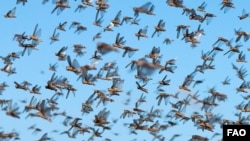More than a year after a locust plague was declared in Madagascar, a control program finally is about to begin. Massive swarms of the insects have damaged or destroyed large areas of cropland and pastures.
Aerial and ground surveys are underway in Madagascar to map the locations of the Malagasy migratory locust swarms.
Annie Monard, locust response coordinator for the U.N. Food and Agriculture Organization, currently is in Madagascar. Monard was among those who sounded the alarm over a year ago.
“It is a plague – no doubt concerning that. It’s a plague because numerous locust swarms escaped the outbreak area. The declaration of plague was made in April 2012.”
Despite the announcement of a locust emergency, the response was slow to develop. That allowed the swarms to spread even further from the southwest where they’re endemic.
The problem began several years earlier when the last control program – funded by the African Development Bank – ended. The FAO launched emergency campaigns in 2010, 2011 and 2012, but they were not enough to stop the locust plague from developing.
“What we did and what FAO does for many, many years is always to promote what we call preventive control strategy. Unfortunately, there are always some situations during which it is not possible to apply the preventive strategy; and progressively the locust situation deteriorated, arising at the level we have now,” she said.
Then late last year, Monard said Madagascar’s agriculture minister requested the FAO’s help in developing a new spraying campaign. That is now scheduled to be conducted in three stages, between October of this year and September 2016. Total cost of the three-year campaign is over $41-million.
“For the time being, we got from a wide range of donors the budget for the first year. But we have still to advocate and to get the budget for the two following campaigns, which will allow us and allow the country to go back to a recession situation,” she said.
The FAO has raised $23 million dollars for the first year of the campaign.
The focus of the spraying will be on hopper bands, when the locusts are still wingless. Hoppers are more sensitive to pesticides that are less harmful to the environment, including those that contain a fungus. Besides spraying hoppers directly, pesticides will be used to create barriers or buffer zones. This is done by spraying the ground every 600 to 800 meters.
It’s estimated that of the 13 million people at risk, about nine million are directly dependent on agriculture for food and income. In some regions, 70 percent of the rice and maize crops have been damaged. As the control program gets underway, the locusts are expected to move to the north where the more productive agricultural lands are located.
Aerial and ground surveys are underway in Madagascar to map the locations of the Malagasy migratory locust swarms.
Annie Monard, locust response coordinator for the U.N. Food and Agriculture Organization, currently is in Madagascar. Monard was among those who sounded the alarm over a year ago.
“It is a plague – no doubt concerning that. It’s a plague because numerous locust swarms escaped the outbreak area. The declaration of plague was made in April 2012.”
Despite the announcement of a locust emergency, the response was slow to develop. That allowed the swarms to spread even further from the southwest where they’re endemic.
The problem began several years earlier when the last control program – funded by the African Development Bank – ended. The FAO launched emergency campaigns in 2010, 2011 and 2012, but they were not enough to stop the locust plague from developing.
“What we did and what FAO does for many, many years is always to promote what we call preventive control strategy. Unfortunately, there are always some situations during which it is not possible to apply the preventive strategy; and progressively the locust situation deteriorated, arising at the level we have now,” she said.
Then late last year, Monard said Madagascar’s agriculture minister requested the FAO’s help in developing a new spraying campaign. That is now scheduled to be conducted in three stages, between October of this year and September 2016. Total cost of the three-year campaign is over $41-million.
“For the time being, we got from a wide range of donors the budget for the first year. But we have still to advocate and to get the budget for the two following campaigns, which will allow us and allow the country to go back to a recession situation,” she said.
The FAO has raised $23 million dollars for the first year of the campaign.
The focus of the spraying will be on hopper bands, when the locusts are still wingless. Hoppers are more sensitive to pesticides that are less harmful to the environment, including those that contain a fungus. Besides spraying hoppers directly, pesticides will be used to create barriers or buffer zones. This is done by spraying the ground every 600 to 800 meters.
It’s estimated that of the 13 million people at risk, about nine million are directly dependent on agriculture for food and income. In some regions, 70 percent of the rice and maize crops have been damaged. As the control program gets underway, the locusts are expected to move to the north where the more productive agricultural lands are located.








